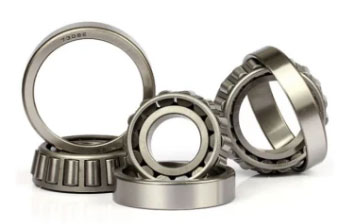Home / News / Unveiling the Essentials of Single-Row Tapered Roller Bearings
Unveiling the Essentials of Single-Row Tapered Roller Bearings
Bearings are vital components in many machines and equipment, enabling them to operate efficiently and reliably. Single-row tapered roller bearings are a widely used bearing type, valued for their simplicity and effectiveness. This article will explore the world of single-row tapered roller bearings, covering their structure, applications, advantages, and maintenance.

Structure of Single-Row Tapered Roller Bearings
As the name implies, single-row tapered roller bearings consist of one row of tapered rollers arranged in parallel. These bearings are designed to accommodate radial and axial loads, as well as combined loads. Each roller is positioned so that it converges at a common point on the bearing axis, ensuring optimal load distribution and efficient performance.
The bearing assembly typically includes the following components:
Inner ring (cone): Contains a roller, cage, and cone.
Outer ring (cup): Houses the roller and cage.
Rollers: The tapered rollers, which serve as the primary load-carrying elements.
Cage: Maintains the proper positioning and spacing of the rollers.
Applications
Single-row tapered roller bearings are used across a range of industries due to their versatility, load-carrying capacity, and precision. Some common applications include:
Automotive: In vehicles, these bearings are often found in wheel hubs, differentials, and transmissions.
Industrial machinery: They support radial and axial loads in various types of machinery, such as pumps, compressors, and conveyor systems.
Agricultural equipment: These bearings are used in tractors, combines, and other agricultural machinery to ensure reliable operation.
General engineering: Their adaptability makes them suitable for a wide range of engineering applications, from robotics to material handling systems.
Single-row tapered roller bearings offer several benefits over other bearing types, including:
Load capacity: Their unique design allows them to handle both radial and axial loads simultaneously, making them suitable for various applications.
Precision: The tapered roller design ensures precise alignment and minimal friction, leading to improved performance and efficiency.
Customization: These bearings can be tailored to specific applications by adjusting the contact angle, which affects the bearing's ability to accommodate axial loads.
Easy installation: The separable design of the inner and outer rings simplifies installation and maintenance.
Maintenance
Proper maintenance is essential to ensure the optimal performance and longevity of single-row tapered roller bearings. Key maintenance practices include:
Regular inspections: Examine the bearings for signs of wear, damage, or contamination during routine equipment maintenance.
Lubrication: Apply the appropriate lubricant to minimize friction, reduce wear, and protect against contaminants.
Bearing replacement: When necessary, replace bearings with identical or equivalent models to maintain the machine's performance and safety.
Alignment: Ensure that bearing components are correctly aligned during installation to prevent excessive stress on the rollers and avoid premature failure.
Single-row tapered roller bearings are versatile, efficient components that play a crucial role in a variety of industries. Their unique design provides excellent load-carrying capacity, precision, and adaptability, making them the bearing of choice for numerous applications. By understanding their structure, applications, advantages, and maintenance requirements, you can ensure the optimal performance and durability of your equipment.
- Previous: Four-row tapered roller bearings
- Next: Delving into the World of Double-Row Tapered Roller Bearings













